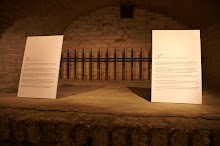Looking out over the bustling river, you think back to how things used to be when the Mississippi’s only traffic was flat-boats piled with hemp and cotton. There were no engines then, river traffic simply floated downstream. You picture yourself in 1823, amazed to see a boat travel against the current, envying the Virginia’s ten lucky passengers.
Now you wish they’d never come. The crews have cut too many trees from the riverbanks to power the steamboat engines. It’s not as if anyone owns those trees; but you think of how much land is barren now, of the bluffs eroding. When you complained in town, no one would listen. Thanks to the riverboats carrying wheat and corn to New Orleans, Kaskaskia had grown to a rich town of seven thousand. Why would anyone question that?
When the riverbanks start to collapse, you say nothing. Everyone puts it down to the rains, and the crews carry on felling trees.
It is only in 1881 that people realise, but it’s too late by then. The Mississippi shifts eastwards into a new channel, destroying most of Kaskaskia. People try to rebuild, but when the town floods again, it is abandoned. Today only nine people remain.
skip to main |
skip to sidebar







According to the UNFPA the population of the world increases by 1.2% a year.
That's 235,000 a day.
That's 235,000 a day.
GENE MEME is a blog, art installation and outreach programme about world population.
The GENE MEME art installation took place in the Crypt Gallery in London from 9 June to 20 June 2010.
The GENE MEME art installation took place in the Crypt Gallery in London from 9 June to 20 June 2010.
GENE MEME was supported by a debate asking what should be done about rising population.



Links to posts
- Ancestral Pueblo culture
- Angkor
- Antioch
- Bodmin Moor
- Cahokia
- China’s Great Leap Forward
- Classical Greece
- Easter Island
- Ephesus
- Fatehpur Sikri
- GENE MEME
- Hawaii
- Hispaniola
- Holodomor
- Illinois
- Juana Maria
- Kaskaskia
- Madagascar
- Minimata
- North Korea’s ‘Arduous March’
- Pitcairn Island
- Rabbits in Australia
- Rwanda
- Smallpox
- St Kilda
- St Matthew Island
- Sugar
- The Aleuts
- The American Dustbowl
- The ancient Olmec civilisation
- The Aral Sea
- The burial of Riez
- The collapse of the Nasca
- The decline of Bruges
- The deforestation of Ethiopia
- The extinction of the Moa
- The Florida Everglades
- The Gambier trade triangle
- The great civilisation of Sumer
- The Harappan Culture
- The Irish potato famine
- the last Nicoleňo
- The last passenger pigeon
- The Mayan civilisation
- The pleistocene extinctions
- The Sahel
- The Vikings in Greenland
Search This Blog

